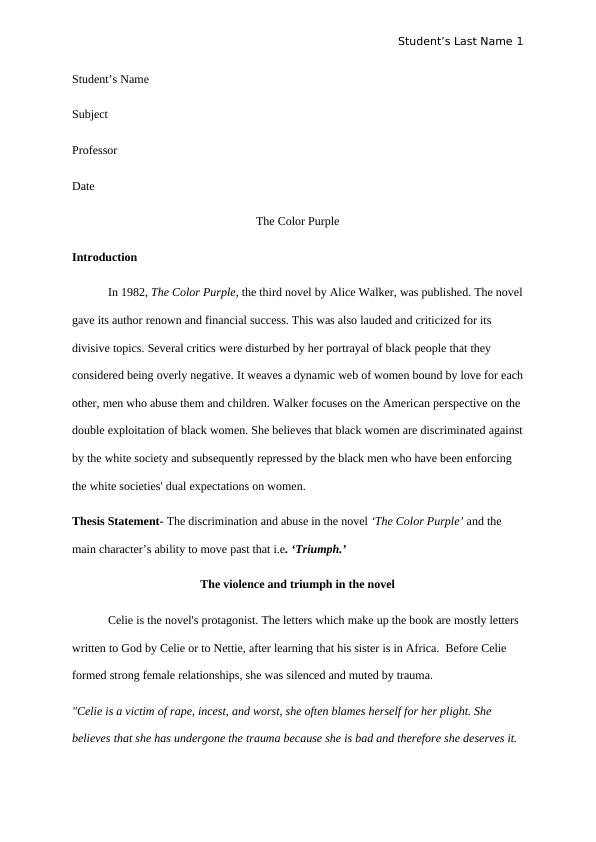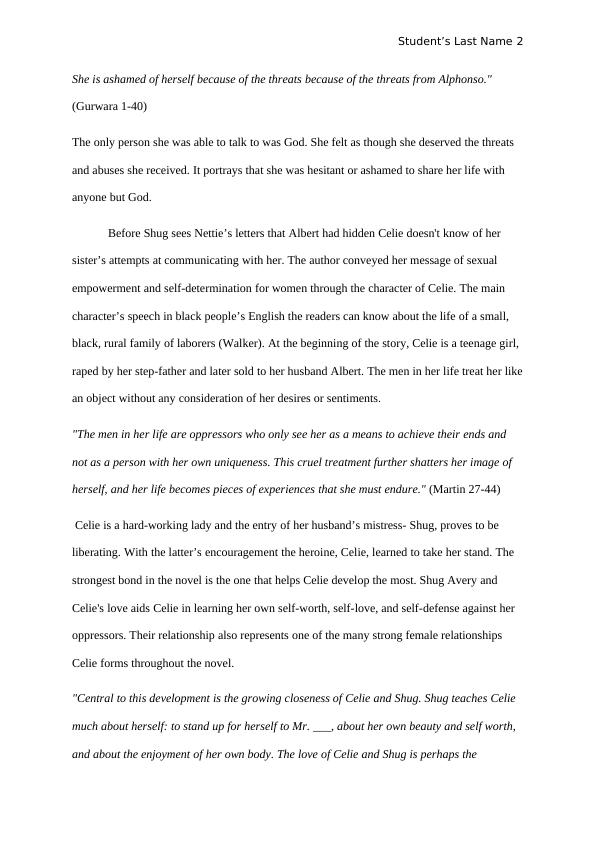The Color Purple, the Third Novel by Alice Walker
5 Pages1512 Words30 Views
Added on 2022-07-29
The Color Purple, the Third Novel by Alice Walker
Added on 2022-07-29
ShareRelated Documents
Student’s Last Name 1
Student’s Name
Subject
Professor
Date
The Color Purple
Introduction
In 1982, The Color Purple, the third novel by Alice Walker, was published. The novel
gave its author renown and financial success. This was also lauded and criticized for its
divisive topics. Several critics were disturbed by her portrayal of black people that they
considered being overly negative. It weaves a dynamic web of women bound by love for each
other, men who abuse them and children. Walker focuses on the American perspective on the
double exploitation of black women. She believes that black women are discriminated against
by the white society and subsequently repressed by the black men who have been enforcing
the white societies' dual expectations on women.
Thesis Statement- The discrimination and abuse in the novel ‘The Color Purple’ and the
main character’s ability to move past that i.e. ‘Triumph.’
The violence and triumph in the novel
Celie is the novel's protagonist. The letters which make up the book are mostly letters
written to God by Celie or to Nettie, after learning that his sister is in Africa. Before Celie
formed strong female relationships, she was silenced and muted by trauma.
"Celie is a victim of rape, incest, and worst, she often blames herself for her plight. She
believes that she has undergone the trauma because she is bad and therefore she deserves it.
Student’s Name
Subject
Professor
Date
The Color Purple
Introduction
In 1982, The Color Purple, the third novel by Alice Walker, was published. The novel
gave its author renown and financial success. This was also lauded and criticized for its
divisive topics. Several critics were disturbed by her portrayal of black people that they
considered being overly negative. It weaves a dynamic web of women bound by love for each
other, men who abuse them and children. Walker focuses on the American perspective on the
double exploitation of black women. She believes that black women are discriminated against
by the white society and subsequently repressed by the black men who have been enforcing
the white societies' dual expectations on women.
Thesis Statement- The discrimination and abuse in the novel ‘The Color Purple’ and the
main character’s ability to move past that i.e. ‘Triumph.’
The violence and triumph in the novel
Celie is the novel's protagonist. The letters which make up the book are mostly letters
written to God by Celie or to Nettie, after learning that his sister is in Africa. Before Celie
formed strong female relationships, she was silenced and muted by trauma.
"Celie is a victim of rape, incest, and worst, she often blames herself for her plight. She
believes that she has undergone the trauma because she is bad and therefore she deserves it.

Student’s Last Name 2
She is ashamed of herself because of the threats because of the threats from Alphonso."
(Gurwara 1-40)
The only person she was able to talk to was God. She felt as though she deserved the threats
and abuses she received. It portrays that she was hesitant or ashamed to share her life with
anyone but God.
Before Shug sees Nettie’s letters that Albert had hidden Celie doesn't know of her
sister’s attempts at communicating with her. The author conveyed her message of sexual
empowerment and self-determination for women through the character of Celie. The main
character’s speech in black people’s English the readers can know about the life of a small,
black, rural family of laborers (Walker). At the beginning of the story, Celie is a teenage girl,
raped by her step-father and later sold to her husband Albert. The men in her life treat her like
an object without any consideration of her desires or sentiments.
"The men in her life are oppressors who only see her as a means to achieve their ends and
not as a person with her own uniqueness. This cruel treatment further shatters her image of
herself, and her life becomes pieces of experiences that she must endure." (Martin 27-44)
Celie is a hard-working lady and the entry of her husband’s mistress- Shug, proves to be
liberating. With the latter’s encouragement the heroine, Celie, learned to take her stand. The
strongest bond in the novel is the one that helps Celie develop the most. Shug Avery and
Celie's love aids Celie in learning her own self-worth, self-love, and self-defense against her
oppressors. Their relationship also represents one of the many strong female relationships
Celie forms throughout the novel.
"Central to this development is the growing closeness of Celie and Shug. Shug teaches Celie
much about herself: to stand up for herself to Mr. ___, about her own beauty and self worth,
and about the enjoyment of her own body. The love of Celie and Shug is perhaps the
She is ashamed of herself because of the threats because of the threats from Alphonso."
(Gurwara 1-40)
The only person she was able to talk to was God. She felt as though she deserved the threats
and abuses she received. It portrays that she was hesitant or ashamed to share her life with
anyone but God.
Before Shug sees Nettie’s letters that Albert had hidden Celie doesn't know of her
sister’s attempts at communicating with her. The author conveyed her message of sexual
empowerment and self-determination for women through the character of Celie. The main
character’s speech in black people’s English the readers can know about the life of a small,
black, rural family of laborers (Walker). At the beginning of the story, Celie is a teenage girl,
raped by her step-father and later sold to her husband Albert. The men in her life treat her like
an object without any consideration of her desires or sentiments.
"The men in her life are oppressors who only see her as a means to achieve their ends and
not as a person with her own uniqueness. This cruel treatment further shatters her image of
herself, and her life becomes pieces of experiences that she must endure." (Martin 27-44)
Celie is a hard-working lady and the entry of her husband’s mistress- Shug, proves to be
liberating. With the latter’s encouragement the heroine, Celie, learned to take her stand. The
strongest bond in the novel is the one that helps Celie develop the most. Shug Avery and
Celie's love aids Celie in learning her own self-worth, self-love, and self-defense against her
oppressors. Their relationship also represents one of the many strong female relationships
Celie forms throughout the novel.
"Central to this development is the growing closeness of Celie and Shug. Shug teaches Celie
much about herself: to stand up for herself to Mr. ___, about her own beauty and self worth,
and about the enjoyment of her own body. The love of Celie and Shug is perhaps the

End of preview
Want to access all the pages? Upload your documents or become a member.
Related Documents
The Colour Purplelg...
|6
|1658
|62
